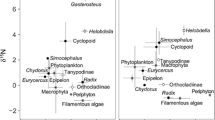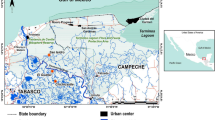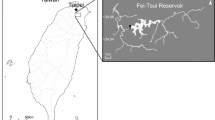Abstract
Physical, chemical and biological processes facilitate cross-habitat connections in lakes, prompting food webs to be supported by different subsidies. We tested the hypothesis that the pelagic food web is subsidized by littoral resources and fish foraging behaviour plays a major role in carbon flux and on food web structure in shallow hypereutrophic lakes. We performed a fish diet and carbon and nitrogen isotope analyses to predict the linkage between littoral and pelagic habitats in three shallow hypereutrophic lakes. Lakes differed in morphology, fetch, macrophyte composition and width of the littoral zone. δ13C signals of seston differed among lakes, but were similar to other producers. Macroinvertebrates and fish carbon signatures were more enriched in the lake co-dominated by emergent and submerged vegetation. Fish foraging behaviour indicates that more than the 80% of the carbon that sustain adult fish was channelled from the littoral. In conclusion, littoral carbon were relevant and sustain, in part, food web in these shallow lakes. Factors like the extension of the littoral zone, lake morphometry, and the dominance of multi-chain omnivorous fish facilitate the connection among lake compartments and the transference of littoral carbon to lake food web.





Similar content being viewed by others
References
Ahlgren, M. O. & S. H. Bowen, 1992. Comparison of quantitative light microscopy techniques used in diet studies of detritus-consuming omnivores. Hydrobiologia 239: 79–83.
Aichner, B., U. Herzschuh & H. Wilkes, 2010. Influence of aquatic macrophytes on the stable carbon isotopic signatures of sedimentary organic matter in lakes on the Tibetan Plateau. Organic Geochemistry 41: 706–718.
Allende, L., G. Tell, H. Zagarese, A. Torremorell, G. Pérez, J. Bustingorry, R. Escaray & I. Izaguirre, 2009. Phytoplankton and primary production in clear-vegetated, inorganic-turbid, and algal-turbid shallow lakes from the pampa plain (Argentina). Hydrobiologia 624: 45–60.
Andersen, T. & D. O. Hessen, 1991. Carbon, nitrogen, and phosphorus content of freshwater zooplankton. Limnology and Oceanography 36: 807–814.
Apha, 1992. Standard methods for the examination of water and wastewater. American Public Health Association, Washington DC.
Attayde, J. L. & J. R. Ripa, 2008. The coupling between grazing and detritus food chains and the strength of trophic cascades across a gradient of nutrient enrichment. Ecosystems 11: 980–990.
Benke, A. C., A. D. Huryn, L. A. Smock & J. B. Wallace, 1999. Length-mass relationships for freshwater macroinvertebrates in North America with particular reference to the Southeastern United States. Journal of the North American Benthological Society 18: 308–343.
Bohn, V. Y., G. M. Perillo & M. C. Piccolo, 2011. Distribution and morphometry of shallow lakes in temparate zone (Buenos Aires Province, Argentina). Limnetica 30: 89–102.
Bottrell, H. H., A. Duncan, Z. M. Gliwicz, E. Grygierek, A. Herzig, A. Hillbricht-Ilkowska, H. Kurasawa, P. Larsson & T. Weglenska, 1976. A review of some problems in zooplankton production studies. Norwegian Journal of Zoology 24: 419–456.
Bowen, S. H., 1979. A nutritional constraint in detritivory by fishes: the stunted population of Sarotherodon mossambicus in Lake Sibaya, South Africa. Ecological Monographs 49: 17–31.
Colautti, D., C. Baigún, F. Llompart, T. Maiztegui, J. Garcia De Souza, P. Solimano, L. Balboni & G. Berasain, 2015. Fish assemblage of a Pampean shallow lake, a story of instability. Hydrobiologia 752: 175–186.
Colautti, D. C., 1998. Design and handling of fish traps in shallow ponds of Buenos Aires Province, Argentina. Revista de Ictiología 6: 17–23.
Coplen, T. B., H. R. Krouse & J. K. Bohlke, 1992. Reporting of nitrogen-isotope abundances. Pure & Applied Chemistry 64: 907–908.
Córdoba, F., 2012. El registro Climático del Holoceno Tardío en Latitudes Medias del SE de Sudamérica: Limnogeología de las Lagunas Encadenadas del Oeste. Universidad Nacional de Córdoba, Córdoba, Argentina.
Crawley, M. J., 2007. The R Book. Wiley, West Sussex.
De Brabandere, L., T. K. Frazer & J. P. Montoya, 2007. Stable nitrogen isotope ratios of macrophytes and associated periphyton along a nitrate gradient in two subtropical, spring-fed streams. Freshwater Biology 52: 1564–1575.
Dionne, M., M. Butler & C. Folt, 1990. Plant-specific expression of antipredator behaviour by larval damselflies. Oecologia 83: 371–377.
Diovisalvi, N., V. Y. Bohn, M. C. Piccolo, G. M. E. Perillo, C. Baigún & H. E. Zagarese, 2015. Shallow lakes from the Central Plains of Argentina: an overview and worldwide comparative analysis of their basic limnological features. Hydrobiologia 752: 5–20.
Dolson, R., K. Mccann, N. Rooney & M. Ridgway, 2009. Lake morphometry predicts the degree of habitat coupling by a mobile predator. Oikos 118: 1230–1238.
Dumont, H. J., I. Van De Velde & S. Dumont, 1975. The dry weight estimate of biomass in a selection of Cladocera, Copepoda and Rotifera from the plankton, periphyton and benthos of continental waters. Oecologia 19: 75–97.
Fee, E. J., R. E. Hecky, S. E. M. Kasian & D. R. Cruikshank, 1996. Effects of lake size, water clarity, and climatic variability on mixing depths in Canadian Shield lakes. Limnology and Oceanography 41: 912–920.
Fellerhoff, C., M. Voss & K. M. Wantzen, 2003. Stable carbon and nitrogen isotope signatures of decomposing tropical macrophytes. Aquatic Ecology 37: 361–375.
France, R. L., 2012. Omnivory, vertical food-web structure and system productivity: stable isotope analysis of freshwater planktonic food webs. Freshwater Biology 57: 787–794.
France, R. L., P. A. Del Giorgio & K. A. Westcott, 1997. Productivity and heterotrophy influences on zooplankton delta13C in northern temperate lakes. Aquatic Microbial Ecology 12: 85–93.
Frost, P. C., S. E. Tank, M. A. Turner & J. J. Elser, 2003. Elemental composition of littoral invertebrates from oligotrophic and eutrophic Canadian Lakes. Journal of the North American Benthological Society 22: 51–62.
Goericke, R., J. P. Montoya & B. Fry, 1994. Physiology of isotopic fractionation in algae and cyanobacteria. In Goericke, R., J. P. Montoya & B. Fry (eds), Stable Isotopes in Ecology and Environmental Sciences. Blackwell Scientific Publications, Boston: 187–229.
Gonfiantini, R., 1978. Standards for stable isotope measurements in natural compounds. Nature 271: 534–536.
González Sagrario, M. A. & E. Balseiro, 2010. The role of macroinvertebrates and fish in regulating the provision by macrophytes of refugia for zooplankton in a warm temperate shallow lake. Freshwater Biology 55: 2153–2166.
González Sagrario, M. A. & L. Ferrero, 2013. The trophic role of Cyphocharax voga (Hensel, 1869) according to habitat foraging and diet analysis in two turbid shallow lakes. Fundamental and Applied Limnology 183: 75–88.
Grey, J., R. I. Jones & D. Sleep, 2000. Stable isotope analysis of the origins of zooplankton carbon in lakes of differing trophic state. Oecologia 123: 232–240.
Grey, J., R. I. Jones & D. Sleep, 2001. Seasonal changes in the importance of the source of organic matter to the diet of zooplankton in Loch Ness, as indicated by stable isotope analysis. Limnology and Oceanography 46: 505–513.
Herman, P. M. J. & C. Heip, 1982. Growth and respiration of Cyprideis torosa Jones 1850 (Crustacea Ostracoda). Oecologia 54: 300–303.
Herwig, B. R., D. A. Soluk, J. M. Dettmers & D. H. Wahl, 2004. Trophic structure and energy flow in backwater lakes of two large floodplain rivers assessed using stable isotopes. Canadian Journal of Fisheries and Aquatic Sciences 61: 12–22.
Izaguirre, I., M. L. Sánchez, M. R. Schiaffino, I. O’farrell, P. Huber, J. Zunino, L. Lagomarsino & M. Mancini, 2015. Which environmental factors trigger the dominance of phytoplankton species across a moisture gradient of shallow lakes? Hydrobiologia 752: 47–64.
Jones, J. I. & S. Waldron, 2003. Combined stable isotope and gut contents analysis of food webs in plant-dominated, shallow lakes. Freshwater Biology 48: 1396–1407.
Keeley, J. E. & D. R. Sandquist, 1992. Carbon: freshwater plants. Plant Cell and Environment 15: 1021–1035.
Kosten, S., M. Vernooij, E. H. Van Nes, M. A. González Sagrario, J. G. P. W. A. Clevers & M. Scheffer, 2012. Bimodal transparency as an indicator for alternative states in South American lakes. Freshwater Biology 57: 1191–1201.
Lee, J.-Y., J.-K. Kim, J. S. Owen, Y. Choi, K. Shin, S. Jung & B. Kim, 2013. Variation in carbon and nitrogen stable isotopes in POM and zooplankton in a deep reservoir and relationship to hydrological characteristics. Journal of Freshwater Ecology 28: 47–62.
Lorenzen, C. J., 1967. Determination of chlorophyll and pheo-pigments: spectrophotometric equations. Limnology and Oceanography 12: 343–346.
Mcintyre, P. B., A. S. Flecker, M. J. Vanni, J. M. Hood, B. W. Taylor & S. A. Thomas, 2008. Fish distributions and nutrient cycling in streams: can fish create biogeochemical hotspots. Ecology 89: 2335–2346.
Mendonça, R., S. Kosten, G. Lacerot, N. Mazzeo, F. Roland, J. P. Ometto, E. Paz, C. P. Bove, N. C. Bueno, J. H. C. Gomes & M. Scheffer, 2013. Bimodality in stable isotope composition facilitates the tracing of carbon transfer from macrophytes to higher trophic levels. Hydrobiologia 710: 205–218.
Moss, B., 2007. The art and science of lake restoration. Hydrobiologia 581: 15–24.
Oksanen, L., S. D. Fretwell, J. Arruda & P. Niemela, 1981. Exploitation ecosystems in gradients of primary productivity. The American Naturalist 118: 240–261.
Osmond, C. B., N. Valaane, S. M. Haslam, P. Uotila & Z. Roksandic, 1981. Comparisons of δ13C values in leaves of quatic macrophytes from different habitats in Britain and Finland; some implications for photosynthetic processes in aquatic plants. Oecologia 50: 117–124.
Parnell, A. C., R. Inger, S. Bearhop & A. L. Jackson, 2010. Source partitioning using stable isotopes: coping with too much variation. PLoS ONE 5: e9672.
Polis, G. A., W. B. Anderson & R. D. Holt, 1997. Toward an integration of landscape and food web ecology: the dynamics of spatially subsidized food webs. Annual Review of Ecology and Systematics 28: 289–316.
Post, M. P., 2002. Using stable isotopes to estimate trophic position: models, methods, and assumptions. Ecology 83: 703–718.
Quirós, R., A. M. Rennella, M. B. Boveri, J. J. Rosso & A. Sosnovsky, 2002. Factores que afectan la estructura y funcionamiento de las lagunas pampeanas. Ecologia Austral 12: 175–185.
Read, J. S. & K. C. Rose, 2013. Physical responses of small temperate lakes to variation in dissolved organic carbon concentrations. Limnology and Oceanography 58: 921–931.
Rowland, F. E., K. J. Bricker, M. J. Vanni & M. J. González, 2015. Light and nutrients regulate energy transfer through benthic and pelagic food chains. Oikos 124: 1648–1663.
Saigo, M., M. R. Marchese & K. M. Wantzen, 2016. Sources contribution for benthic invertebrates: an inter-lake comparison in a flood plain system. Hydrobiologia 770: 27–36.
Schindler, D. E. & M. D. Scheuerell, 2002. Habitat coupling in lake ecosystems. Oikos 98: 177–189.
Small, G. E., C. M. Pringle, M. Pyron & J. H. Duff, 2010. Role of the fish Astyanax aeneus (Characidae) as a keystone nutrient recycler in low-nutrient Neotropical streams. Ecology 92: 386–397.
Solomon, C. T., S. R. Carpenter, M. K. Clayton, J. J. Cole, J. J. Coloso, M. L. Pace, M. J. Vander Zanden & B. C. Weidel, 2011. Terrestrial, benthic, and pelagic resource use in lakes: results from a three-isotope Bayesian mixing model. Ecology 92: 1115–1125.
Stenroth, P., N. Holmqvist, P. Nyström, O. Berglund, P. Larsson & W. Granéli, 2008. The influence of productivity and width of littoral zone on the trophic position of a large-bodied omnivore. Oecologia 156: 681–690.
Teixeira-De Mello, F., M. Meerhoff, Z. Pekcan-Hekim & E. Jeppesen, 2009. Substantial differences in littoral fish community structure and dynamics in subtropical and temperate shallow lakes. Freshwater Biology 54: 1202–1215.
Vadeboncoeur, Y., K. S. Mccann, M. J. Vanderzanden & J. B. Rasmussen, 2005. Effects of multi-chain omnivory on the strength of trophic control in lakes. Ecosystems 8: 682–693.
Vadeboncoeur, Y., G. Peterson, M. J. Vander Zanden & J. Kalff, 2008. Benthic algal production across lake size gradients: interactions among morphometry, nutrients and light. Ecology 89: 2542–2552.
Valderrama, J. C., 1981. The simultaneous analysis of total nitrogen and total phosphorus in natural waters. Marine Chemistry 10: 109–122.
Vander Zanden, M. J. & Y. Vadeboncoeur, 2002. Fishes as integrators of benthic and pelagic food webs in lakes. Ecology 83: 2152–2161.
Vander Zanden, M. J., Y. Vadeboncoeur & S. Chandra, 2011. Fish reliance on littoral–benthic resources and the distribution of primary production in lakes. Ecosystems 14: 894–903.
Vanni, M. J., G. Boros & P. B. Mcintyre, 2013. When are fish sources vs. sinks of nutrients in lake ecosystems? Ecology 94: 2195–2206.
Vanni, M. J., A. M. Bowling, E. M. Dickman, R. S. Hale, K. A. Higgins, M. J. Horgan, L. B. Knoll, W. H. Renwick & R. A. Stein, 2006. Nutrient cycling by fish supports relatively more primary production as lake productivity increases. Ecology 87: 1696–1709.
Vanni, M. J., A. S. Flecker, J. M. Hood & J. L. Headworth, 2002. Stoichiometry of nutrient recycling by vertebrates in a tropical stream: linking species identity and ecosystem processes. Ecology Letters 5: 285–293.
Wetzel, R. G. & G. E. Likens, 1991. Limnological Analyses. Springer-Verlag, New York.
Wilkinson, G. M., S. R. Carpenter, J. J. Cole, M. L. Pace & C. Yang, 2013. Terrestrial support of pelagic consumers: patterns and variability revealed by a multilake study. Freshwater Biology 58: 2037–2049.
Winemiller, K. O., 1990. Spatial and temporal variation in tropical fish trophic networks. Ecological Monographs 60: 331–367.
Zhang, H., G. Wu, P. Zhang & J. Xu, 2013. Trophic fingerprint of fish communities in subtropical floodplain lakes. Ecology of Freshwater Fish 22: 246–256.
Acknowledgements
We thank the two anonymous reviewers for their comments that have improved our manuscript, R. Inger (University of Exeter) for the valuable discussion and help with SIAR, M. Vanni (Miami University) for sharing his original data of fish carbon content, G. Bernava (IIMYC-CONICET/UNMDP) for technical assistance, and E. Ducos (INGEIS-CONICET/UBA) who performed the isotope analysis. We acknowledged the landowners and managers for their permission and assistance to enter to the private lands where the lakes are located, especially to P. Urrutia, H. Sanabria and González Aguilar family. This research was supported by the Agencia de Promoción Científica y Tecnológica (PICT 384), Consejo Nacional de Investigaciones Científicas y Tecnológicas (CONICET) (PIP 1328, 465), and Universidad Nacional de Mar del Plata (EXA 418-08 y EXA 529-10). M.A.G.S.& H.P. are CONICET researchers.
Author information
Authors and Affiliations
Corresponding author
Additional information
Handling editor: Mariana Meerhoff
Rights and permissions
About this article
Cite this article
González Sagrario, M.A., Rodríguez Golpe, D., La Sala, L. et al. Lake size, macrophytes, and omnivory contribute to food web linkage in temperate shallow eutrophic lakes. Hydrobiologia 818, 87–103 (2018). https://doi.org/10.1007/s10750-018-3594-z
Received:
Revised:
Accepted:
Published:
Issue Date:
DOI: https://doi.org/10.1007/s10750-018-3594-z




